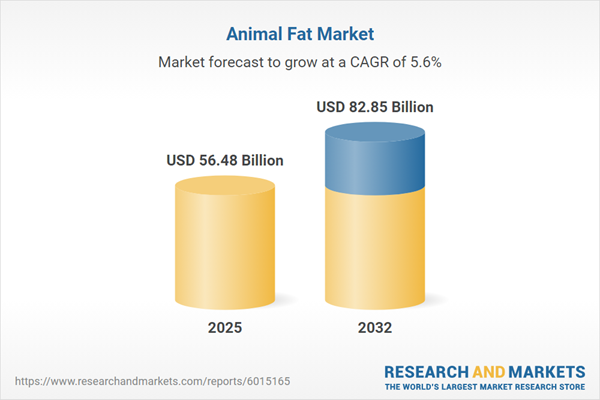Speak directly to the analyst to clarify any post sales queries you may have.
The animal fat market is undergoing significant transformation as sustainability, digitization, and regulatory shifts redefine value creation for senior decision-makers. As companies confront dynamic supply chains and new compliance demands, clear strategic insight is critical for maintaining growth and operational resilience.
Market Snapshot: Animal Fat Market Size and Growth Outlook
The animal fat market is projected to expand from USD 53.40 billion in 2024 to USD 56.48 billion in 2025 before reaching USD 82.85 billion by 2032, corresponding to a CAGR of 5.64%. This growth is fueled by evolving environmental mandates and broadening applications across sectors—ranging from manufacturing to pharmaceuticals and renewables. Businesses leveraging digital supply chain solutions and advanced processing capabilities are better positioned to capitalize on changes in technology, regulatory environments, and market demand. These trends reflect increased focus on operational agility, risk management, and adaptability for continued market relevance.
Scope & Segmentation of the Animal Fat Market
The animal fat market encompasses a range of product types, applications, and sourcing strategies that allow for targeted growth across global industries. Senior executives evaluating market opportunities should consider the relevance and impact of each segment:
- Application: Animal fats are used in animal feed, biofuels, food, pharmaceuticals, and cosmetics. Subcategories include bakery, confectionery, frozen foods, processed meats, skincare, haircare, and animal nutrition, expanding both traditional and emerging use cases.
- Type: The market includes fish oil (in both crude and refined forms), lard (refined and unrefined), and beef or mutton tallow, each supporting specific industrial and consumer requirements.
- Source: Products are derived from bovine (cattle, buffalo), porcine (pigs, wild boar), poultry (chicken, duck), and marine (fish, shellfish oils) origins. Source selection impacts end-user preference and quality assurance frameworks.
- Form: Animal fats are available in both liquid and solid formats, affecting supply chain efficiency, storage options, and transportation strategies.
- Distribution Channel: Distribution spans specialty stores, supermarkets, wholesale networks, direct online sales, and ecommerce platforms, providing diversified routes to end-users and market flexibility.
- Regional Segmentation: Market presence and performance varies across the Americas, Europe, Middle East & Africa, and Asia-Pacific, with strategies adapted to distinct regulatory conditions and customer behaviors.
- Major Companies Examined: Competitive tactics and market positioning are reviewed for JBS S.A., Tyson Foods Inc., Cargill Incorporated, Marfrig Global Foods S.A., WH Group Limited, Hormel Foods Corporation, Danish Crown A.m.b.a., NH Foods Ltd., OSI Group LLC, and Westfleisch SCE mbH, highlighting varied approaches across industry leaders.
Key Takeaways for Senior Decision-Makers
- Industry leaders are increasing transparency through digital traceability and innovative processing systems, supporting consistent compliance with both local and global regulations.
- Expanded research and development is enabling new uses for animal fat in sectors such as renewable energy and advanced pharmaceuticals, helping to diversify end-market reach.
- More agile supply chain models are being established, improving responsiveness to shifts in policy, demand, and global trade movements.
- Strategic collaborations between industries are creating opportunities for animal fats to be integrated into additional high-value applications, resulting in broader diversification of revenue streams.
- Digital technologies, including blockchain and data analytics, are streamlining procurement, enhancing operational efficiency, and strengthening risk management in sourcing and distribution.
Tariff Impact on Supply Chain Resilience
Recent changes to U.S. tariffs have prompted suppliers to revise procurement and logistics strategies to maintain cost control and operational stability. Companies are renegotiating contracts, diversifying sourcing, and reconsidering trade routes to preserve business continuity and capitalize on export opportunities within Asian and European markets. Increased investment in domestic processing is aiding adaptation to global supply disruptions and ensuring workforce flexibility under evolving trade policies.
Methodology & Data Sources
This report is based on extensive secondary research, regulatory document analysis, and direct input from stakeholders via interviews and surveys. Triangulation and peer validation ensure data integrity, supporting informed and reliable decision-making for executive leaders.
Why This Report Matters
- Enables executives to craft growth strategies amid regulatory change and shifting global demand.
- Provides practical tools for risk management and innovation, supporting adaptation to standards and new business opportunities.
- Offers expert insights on competitor moves, regional variability, and technology integration to inform investment and partnership considerations.
Conclusion
As the animal fat market adapts to new technology and regulatory contexts, stakeholders with proactive strategies and operational flexibility will be best equipped to realize value and secure future market standing.
Additional Product Information:
- Purchase of this report includes 1 year online access with quarterly updates.
- This report can be updated on request. Please contact our Customer Experience team using the Ask a Question widget on our website.
Table of Contents
3. Executive Summary
4. Market Overview
7. Cumulative Impact of Artificial Intelligence 2025
Companies Mentioned
The companies profiled in this Animal Fat market report include:- JBS S.A.
- Tyson Foods, Inc.
- Cargill, Incorporated
- Marfrig Global Foods S.A.
- WH Group Limited
- Hormel Foods Corporation
- Danish Crown A.m.b.a.
- NH Foods Ltd.
- OSI Group, LLC
- Westfleisch SCE mbH
Table Information
| Report Attribute | Details |
|---|---|
| No. of Pages | 183 |
| Published | October 2025 |
| Forecast Period | 2025 - 2032 |
| Estimated Market Value ( USD | $ 56.48 Billion |
| Forecasted Market Value ( USD | $ 82.85 Billion |
| Compound Annual Growth Rate | 5.6% |
| Regions Covered | Global |
| No. of Companies Mentioned | 11 |









